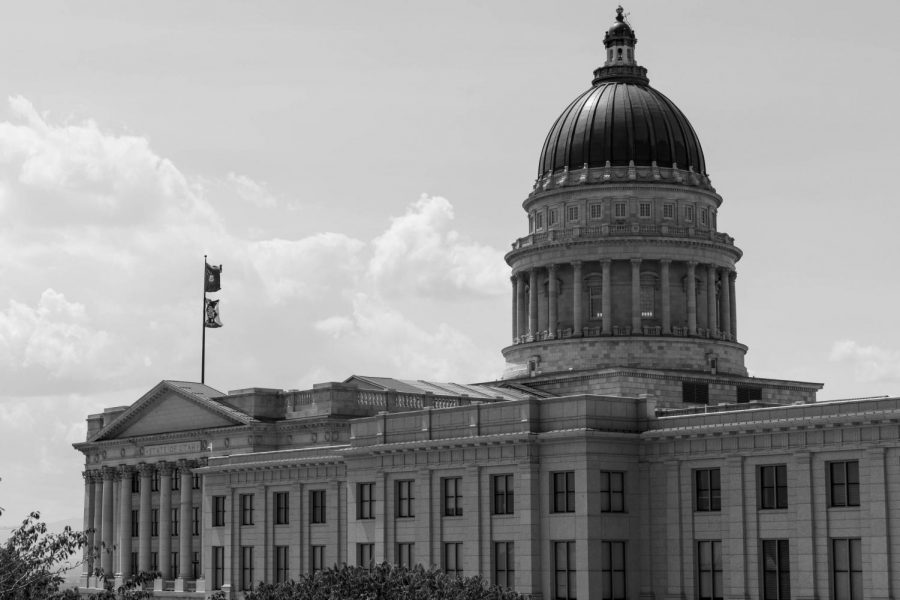Kincart: An Inaccessible Government Means Nothing
A view of the Utah State Capitol Building in Salt Lake City on Aug. 21, 2021. (Photo by Kevin Cody | The Daily Utah Chronicle)
August 25, 2021
This August, a biennial report from the Office of Congressional Workplace Rights highlighted the U.S. Capitol’s inaccessibility. It identified 1,996 barriers within the Capitol complex, excluding the Hart Senate Office Building. The report also deemed eight barriers as “whole facility” barriers because they appear throughout the entire complex. Unfortunately, not many people have discussed this astounding report. The current rhetoric and action around accessible government buildings must be improved. Democracy and accessibility go hand in hand, and we can’t let accessibility issues remain invisible.
The Americans with Disabilities Act passed 31 years ago. Before 1990, discrimination on the basis of disability was technically legal. The U.S. House reconstructed the speaker’s rostrum in 2008 because of US Congressman Jim Langevin. As a wheelchair user, he had experienced the inaccessibility of the Capitol since his days as a Senate intern in 1984. The inaccessibility of government buildings affected him throughout the duration of his career, up until his election. Still, the biennial report indicates that the reconstruction of the dais didn’t eliminate all of the Capitol’s inaccessibility.
This trend of making elements of government buildings accessible continues as more disabled leaders are elected. In 2020, Colorado installed ramps, in addition to new doors and desks, in their capital as Rep. David Ortiz entered office. Ortiz, another wheelchair user, said, “obviously the most urgent thing was to make sure I could at least do my job.”
It’s heart-wrenching that the inaccessibility of government buildings led him to make this statement. But it captures the necessity of proactive accessibility in capitol buildings. When the legislature waits until fellow legislators themselves require accessibility features, it signals that disabled voices aren’t welcome in the government. This exclusivity affects those wishing to visit government buildings to learn, protest, lobby and cast votes inside of Capitols. The current trend of waiting until accessibility is unavoidable sends a hurtful message to disabled people, and we must do more to combat this.
Although this report fails to encompass the entire Capitol complex’s accessibility, we need to act promptly. Neglecting the Hart Senate Office Building in the report would be a disservice as it topped other Senate buildings for barriers in previous reports. The cost of accessibility shouldn’t be the focus of this issue because we need accessible government buildings to further representation.
Disability representation personally affects many lives. Similarly, those with disabilities make up the largest minority in the U.S. We shouldn’t leave such a large group behind. More disability representation in Congress opens discussion about issues faced by those with disabilities — especially accessibility. Their voices will add invaluable information to discussions of healthcare, social security, housing policy, education policy and other areas of policy that have disproportionate impacts on those with disabilities. We further the promise of democracy as we increase accessibility in our government. That promise should outweigh the costs associated with a Capitol complex renovation.
Not only does the Capitol complex need updating, but so do online resources. We need to address the digital disability divide. Closed captioning can be available for all virtual meetings. After all the time we spent navigating online resources during the COVID-19 pandemic, there’s no excuse for inaccessible online meetings. Congressional documents and websites as a whole should be compatible with assistive technology. Making voting locations accessible would also step toward promoting representation.
During the 2016 election, less than 20% of polling places were entirely accessible. These statistics need to change to further a representative government. Accessible polling locations have voting systems assembled correctly, therefore not impeding on the machine’s accessibility features. The positioning of these systems should offer the same amount of privacy as those used by other voters.
Additionally, physical barriers to accessibility like parking, sidewalks, hallways and the voting area itself must be eliminated. Title II of the Americans with Disabilities Act requires that people can use and access the voting facilities in public entities. It’s already law, so let’s finally enforce it.
This discourse plays a key part in prompting tangible change. We need to advocate for change on all fronts of disability — not just the Capitol complex. Accessibility affects where we live, eat, shop, study and conduct all facets of our lives. The inaccessibility of the Capitol complex is just one aspect of the barriers faced by those with disabilities. As these issues gain more attention, change on all fronts can finally be made.














Everette Bacon • Aug 27, 2021 at 9:29 am
I appreciate the passion in the article, but you may want to make sure your own website is accessible. You have mislabelled links and even an unlabelled button. Also, you should have stated that the ADA law does not apply to Congress and their facilities. You can’t call on them to be compliant to a law that does not apply to them.